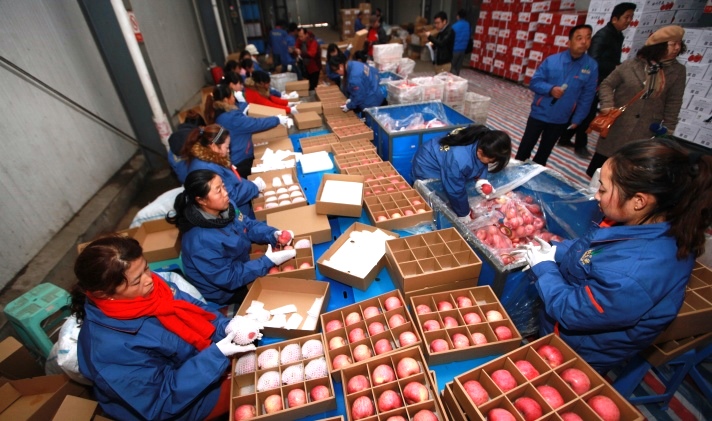
Background:
In 2009, clusters of rural online entrepreneurs who have opened shops on Taobao Marketplace, which are referred to as “Taobao Villages,” began to emerge in China. The first farming village to take up e-commerce on a large scale was Dongfeng Village in Shaji Town, Jiangsu Province, where more than 1,000 households had joined the digital economy by getting involved in furniture production and selling their finished goods online. Two other Taobao Villages also emerged in Hebei Province and Zhejiang Province, respectively, in the same year. Since then, the number of Taobao Villages has been on the rise, and those villages have become a significant force behind the development of rural e-commerce in China.
Definition of a “Taobao Village (Ê∑òÂÆùÊùë)“:
As defined by AliResearch, Alibaba Group’s research arm, a Taobao Village is a cluster of rural e-tailers within an administrative village where:
- Residents got started in e-commerce spontaneously primarily with the use of Taobao Marketplace;
- Total annual e-commerce transaction volume is at least RMB10 million ($1.6 million);
- At least 10% of village households actively engage in e-commerce or at least 100 active online shops have been opened by villagers.
Emergence of “Taobao Towns (Ê∑òÂÆùÈïá)”:
In some rural areas, e-commerce is gaining sufficient scale to lead to the formation of bigger clusters of rural e-tailers. These bigger clusters are referred to as “Taobao Towns” and a “Taobao Town” is defined as a town, township or street that comprises at least three Taobao Villages. The first batch of 19 “Taobao Towns” came into being in 2014.
NEW DEVELOPMENTS IN 2015
The following facts and figures are extracted from the 2015 China Taobao Villages Research Report (2015年中国淘宝村研究报告) developed by AliResearch:
Statistics at a glance:
780 Taobao Villages
200,000+ activeonline shops
17 provinces and municipalities
71 Taobao Towns
25 Taobao Village Clusters
- The number of Taobao Villages and Taobao Towns has grown rapidly. As of the end of 2015, the number of Taobao Villages identified in China grew 268% year-on-year to 780, compared with 212 as of the end of 2014 and 20 as of the end of 2013. Those 780 villages, where there are more than 200,000 active online shops, span 17 provinces and municipalities. The coastal provinces of Zhejiang, Guangdong and Jiangsu accounted for the biggest number of Taobao Villages. Meanwhile, seven provinces and municipalities made the list of Taobao Villages for the first time in 2015.
Geographic distribution of Taobao Villages
| No. | Province/ Municipality |
No. of Taobao Villages | No. | Province/ Municipality |
No. of Taobao Villages |
| 1 | Zhejiang | 280 | 10 | Tianjin | 3 |
| 2 | Guangdong | 157 | 11 | Sichuan | 2 |
| 3 | Jiangsu | 127 | 12 | Yunnan | 2 |
| 4 | Fujian | 71 | 13 | Beijing | 1 |
| 5 | Shandong | 64 | 14 | Hubei | 1 |
| 6 | Hebei | 59 | 15 | Jilin | 1 |
| 7 | Henan | 4 | 16 | Liaoning | 1 |
| 8 | Hunan | 3 | 17 | Ningxia | 1 |
| 9 | Jiangxi | 3 |
* Italics highlight provinces/municipalities that made the list for the first time.
Meanwhile, the number of Taobao Towns grew 274% to 71 as of the end of 2015, compared with 19 as of the end of 2014.
Geographic distribution of Taobao Towns
| No. | Province | No. of Taobao Villages | No. | Province | No. of Taobao Villages |
| 1 | Guangdong | 22 | 4 | Fujian | 7 |
| 2 | Zhejiang | 20 | 5 | Shandong | 6 |
| 3 | Jiangsu | 11 | 6 | Hebei | 5 |
- Taobao Villages differ greatly in terms of transaction scale. Among the 780 Taobao Villages identified in 2015, some have just surpassed RMB10 million in annual sales while others have already reached an annual transaction scale of several billion yuan. More than 30 Taobao Villages, most of them located in Guangzhou and Yiwu, are estimated to have achieved annual sales of more than RMB100 million. 60% of all Taobao Villages achieved RMB10 million to RMB30 million in annual sales.
- Apparel, furniture and shoes remained the best-selling products for Taobao Village merchants. Apparel, furniture and shoes continued to be the best-selling product categories. The full list of top 10 product categories in terms of 2015 sales were:
| Ranking | Product category | Ranking | Product category |
| 1 | Apparel | 6 | Toys |
| 2 | Furniture | 7 | Home products |
| 3 | Shoes | 8 | Bedding products |
| 4 | Automobile accessories | 9 | Outdoor products |
| 5 | Bags, luggage and leather products | 10 | Home improvement materials |
Products sold by Taobao Villages are becoming increasingly diversified. Many villages specialize in unique products such as honey, musical instruments, ceramics, purple clay teapots and silverware.
- The first group of “Taobao Village Clusters (Ê∑òÂÆùÊùëÈõÜÁæ§)” came into existence. In some places, Taobao Villages began to form in groups to become “Taobao Village Clusters.” In Xinhe Town, Shuyang County of Jiangsu Province, for example, all the 10 administrative villages there have fulfilled the criteria of Taobao Villages. A “Taobao Village Cluster” is officially defined as:
- A cluster of more than 10 neighboring Taobao Villages that develop together
- where e-commerce entrepreneurs, service providers, the regional government and industry associations work closely together and
- whose annual e-commerce transaction volume reaches or exceeds RMB100 million.
Taobao Village Clusters formed by 30 or more neighboring Taobao Villages are referred to as “Mega Taobao Village Clusters (§ßÂûãÊ∑òÂÆùÊùëÈõÜÁæ§).” Among the 25 Taobao Village Clusters that emerged in 2015, Yiwu and Cao County were considered Mega Taobao Village Clusters.
Top 10 Taobao Village Clusters
| No. | District / County | City | No. of Taobao Villages |
| 1 | Yiwu | Jinhua | 37 |
| 2 | Cao County | Heze | 34 |
| 3 | Jinjiang | Quanzhou | 25 |
| 4 | Puning | Jieyang | 25 |
| 5 | Shuyang | Suqian | 22 |
| 6 | Suining | Xuzhou | 22 |
| 7 | Baiyun | Guangzhou | 21 |
| 8 | Chaonan | Shantou | 21 |
| 9 | Wenling | Taizhou | 21 |
| 10 | Zhuji | Shaoxing | 20 |
* Italics signify Mega Taobao Village Clusters.
The reasons behind this development include:
- Villagers have naturally spread e-commerce to neighboring villages through their connections.
- In some cases, the neighboring villages are involved in similar industries and they are naturally attracted by the success of the Taobao Villages to join the wave of e-commerce.
- The government policy in some regions is conducive to the development and expansion of e-commerce.
- An increasing number of Taobao Villages participate in cross-border trade. As some Taobao Villages mature and their products become more high-end, and Alibaba Group’s retail platforms become more globalized, an increasing number of Taobao Villages have engaged in cross-border trade. For example, the Taobao Villages in Cao County of Shandong Province, which started online trade with children’s stage costumes and later expanded their product range to adult stage costumes, dance shoes, corporate uniforms, etc, have recently moved beyond their home market to produce Halloween and Christmas costumes for overseas customers as well.
- B2B e-commerce villages started to emerge. Taobao Villages are no longer only involved in online retail. AliResearch data shows that B2B e-commerce villages began to emerge on a large scale in 2015, thanks to factors such as rising Internet penetration, the low entry barrier offered by e-commerce platforms, and examples from others in the rural community. As an example, Zhuji in Zhejing Province is the world’s biggest manufacturing base of socks, accounting for 70% of all socks produced in China and 30% of the world’s total in 2014. In recently years, e-tailers in Zhuji began to engage in both wholesale and retail, supplying socks to Taobao sellers in other regions and offline retailers, while also selling their products to consumers through their online shops.
- More impoverished regions have joined the wave of e-commerce. Taobao Villages first started to emerge in certain country-level impoverished counties in 2014, and the number grew from four to 10 in the course of 2015. The number of Taobao Villages located in province-level impoverished countries has even reached 166 as of the end of 2015.
Editor’s note: This information is current as of January 2016.




